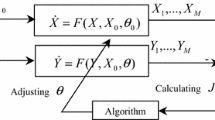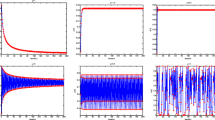Abstract
The prediction of chaotic time series is an important issue in nonlinear information procession. Due to the multi-modal, high-dimensional and non-differentiable or discontinuous characteristics of chaotic systems, global optimization techniques are required to avoid from falling into local optima for the prediction of chaotic time series. Phase-based optimization is recently proposed as a global search algorithm inspired by natural phenomena. In this paper, an improved phase-based optimization algorithm integrating stochastic interaction strategy and global optimal interaction strategy, termed interactive phase-based optimization (IPBO), is proposed to train feed-forward neural networks (FNNs) for chaotic time series prediction. The combination of stochastic interaction strategy and global optimal interaction strategy can balance the capability of exploration and exploitation in the global optimization process. To demonstrate the searching capability, sixteen widely used benchmark functions are firstly used to investigate its optimization performance. Then, the prediction effectiveness of FNNs trained by IPBO has been illustrated using classical chaotic time series of Lorenz, Box–Jenkins and Mackey–Glass. The training and testing performances of IPBO and other state-of-the-art optimization algorithms have been compared for predicting these time series. Conducted numerical experiments indicate that IPBO is not only competitive in functions optimization and has also a better learning ability in training FNNs among other state-of-the-art optimization algorithms.









Similar content being viewed by others
References
Abarbanel HDI (1996) Analysis of observed chaotic data. Springer, New York
Akaike H (1969) Fitting autoregressive models for prediction. Ann Inst Stat Math 21(1):243–247
Aly M, Leung H (2001) Chaotic time series prediction using data fusion. In: International conference on data fusion (FUSION2001), Montreal, Canada
Ardalani-Farsa M, Zolfaghari S (2010) Chaotic time series prediction with residual analysis method using hybrid Elman-NARX neural networks. Neurocomputing 73(13):2540–2553
Basharat A (2009) M. Shah, Time series prediction by chaotic modeling of nonlinear dynamical systems. In: IEEE 12th international conference on computer vision, pp 1941–1948
Cao ZJ, Wang L, Hei XH et al (2016) A phase based optimization algorithm for big optimization problems. In: 2016 IEEE congress on evolutionary computation (CEC), pp 5209–5214
Casdagli M (1989) Nonlinear prediction of chaotic time-series. Physica D 35:335–356
Civicioglu P (2012) Transforming geocentric Cartesian coordinates to geodetic coordinates by using differential search algorithm. Comput Geosci 46(9):229–247
Civicioglu P (2013) Artificial cooperative search algorithm for numerical optimization problems. Inf Sci 229:58–76
Damle C, Yalcin A (2007) Flood prediction using time series data mining. J Hydrol 333(2):305–316
Ha M, Wang C, Chen J (2013) The support vector machine based on intuitionistic fuzzy number and kernel function. Soft Comput 17(4):635–641
Hyndman R (2008) Forecasting with exponential smoothing. Springer, New York, p 2008
Jiang QY, Wang L, Hei XH, Yu GL, Lin Y (2016) The performance comparison of a new version of artificial raindrop algorithm on global numerical optimization. Neurocomputing 179:1–25
Karunasinghe DS, Liong SY (2006) Chaotic time series prediction with a global model: artificial neural network. J Hydrol 323(1):92–105
Lacerda E, Carvalho A, Ludermir T (2001) Evolutionary optimization of RBF networks. Int J Neural Syst 11(03):287–294
Liang J, Qin AK, Suganthan PN, Baskar S (2006) Comprehensive learning particle swarm optimizer for global optimization of multimodal functions. IEEE Trans Evol Comput 10(3):281–295
Lorenz EN (1969) Deterministic non-periodic flow. J Atoms Sci 26(636):1969
Mackey MC, Glass J (1977) Oscillation and chaos in physiological control systems. Science 197:287
Michael N (2005) Artificial intelligence: a guide to intelligent systems. Pearson Education Limited, London
Navarro J (2008) ARMA prediction of widely linear systems by using the innovations algorithm. IEEE Trans Signal Process 56(7):3061–3068
Prakash B, Jayashri S, Karthik TS (2019) A hybrid genetic artificial neural network (G-ANN) algorithm for optimization of energy component in a wireless mesh network toward green computing. Soft Comput 23(8):2789–2798
Qin AK, Huang VL, Suganthan PN (2009) Differential evolution algorithm with strategy adaptation for global numerical optimization. IEEE Trans Evol Comput 13(2):398–417
Sakamoto S, Ozera K, Barolli A (2019) Implementation of an intelligent hybrid simulation systems for WMNs based on particle swarm optimization and simulated annealing: performance evaluation for different replacement methods. Soft Comput 23(9):3029–3035
Samantha B (2011) Prediction of chaotic time series using computational intelligence. Expert Syst Appl 38(9):11406–11411
Sayeekumar M, Karthik GM, Puhazholi S (2019) Hybrid intelligence system using fuzzy inference in cluster architecture for secured group communication. Soft Comput 23(8):2727–2734
Sheela KG, Deepa SN (2014) Performance analysis of modeling framework for prediction in wind farms employing artificial neural networks. Soft Comput 18(3):607–615
Stark J (1993) Recursive prediction of chaotic time series. J Nonlinear Sci 3(1):197–223
Veeramachaneni K, Peram T, Mohan C, Osadciw CLA (2003) Optimization using particle swarms with near neighbor interactions. In: Genetic and evolutionary computation conference, Springer, Berlin, pp 110–121
Wang Y, Cai ZX, Zhang Q (2011) Differential evolution with composite trial vector generation strategies and control parameters. IEEE Trans Evol Comput 15(1):55–66
Wang L, Zou F, Hei XH et al (2014) A hybridization of teaching-learning-based optimization and differential evolution for chaotic time series prediction. Neural Comput Appl 25(6):1407–1422
Wang D, Tan D, Liu L (2018) Particle swarm optimization algorithm: an overview. Soft Comput 22(2):387–408
Funding
This research was funded by the Shaanxi Natural Science Basic Research Project (Grant No.2020JM-565), the fund of National Laboratory of Network and Detection Control (Grant No. GSYSJ2016007), the research project on teaching reform of Xi’an Technological University (Grant No. 18JGZ03), and the national innovation and entrepreneurship training program for college students (Grant No. 1070214030).
Author information
Authors and Affiliations
Corresponding author
Ethics declarations
Conflict of interest
Zijian Cao has received research grants from Xi’an Technological University, and declares that he has no conflict of interest.
Ethical approval
This article does not contain any studies with human participants or animals performed by any of the authors.
Informed consent
Informed consent was obtained from all individual participants included in the study.
Additional information
Communicated by V. Loia.
Publisher's Note
Springer Nature remains neutral with regard to jurisdictional claims in published maps and institutional affiliations.
Rights and permissions
About this article
Cite this article
Cao, Z. Evolutionary optimization of artificial neural network using an interactive phase-based optimization algorithm for chaotic time series prediction. Soft Comput 24, 17093–17109 (2020). https://doi.org/10.1007/s00500-020-05002-7
Published:
Issue Date:
DOI: https://doi.org/10.1007/s00500-020-05002-7




